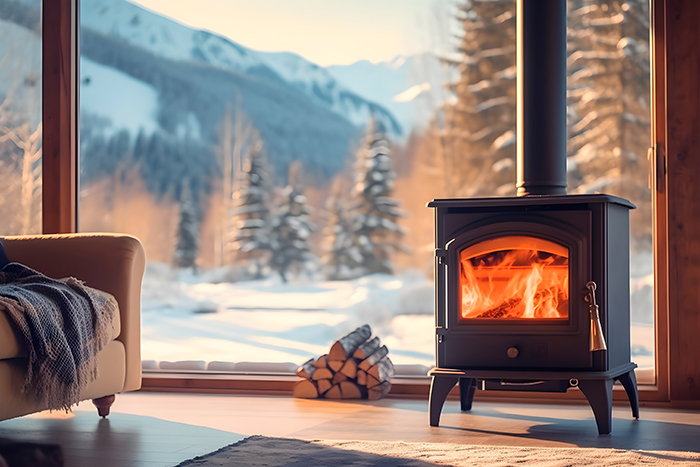How to choose a supplementary heating system
When temperatures drop, supplementary heating helps keep your home comfortable while saving on your electricity bill. In this article, we’ll cover five ways to supplement electric baseboard heating or a heat pump. Read on to find out how to stay warm without busting your budget.

1. Fireplace and wood-burning stove
Today’s fireplaces and wood-burning stoves are more environmentally friendly than older models, as they burn fuel more efficiently to maximize heat output while releasing fewer particles into the air. A fireplace fire provides radiant heat and a cozy atmosphere, even in the event of a power outage. However, storing firewood requires effort and space. Fireplaces and wood stoves also require regular maintenance and don’t come with a temperature control system.[1]
2. Pellet stove
Pellet stoves work similarly to fireplaces. However, you don’t have to install a chimney through the roof—a flue or pipe is enough to vent the smoke.[2] One of the main advantages of pellet stoves is that they require little storage space and maintenance while providing consistent, even heat. They are more expensive than wood-burning fireplaces and should be swept (cleaned) once a year.
3. Natural gas or propane fireplace
Natural gas and propane fireplaces don’t need a chimney, just a vent or flue.[3] Since it has a thermostat, you can turn a gas fireplace on and off when you want to better regulate the temperature in your home.
However, propane doesn’t crackle or smell the same way as wood does when it burns, so a natural gas fireplace doesn’t provide the same picturesque winter ambiance as wood. Propane and gas fireplaces must be certified by the Canadian Gas Association (CGA) and installed by a specialized contractor.[4]
4. Electric floor heating
Floor heating consists of a system of electric cables that are usually installed in a bathroom or at the main entrance. You can control the temperature with a thermostat. However, this kind of under-floor heating requires major renovations to install and is only perfectly compatible with concrete, stone and ceramic flooring.[5]
5. Portable space heater
Portable space heaters are the safest type of supplementary heating—simply plug the heater into a power outlet. It must be positioned at least one metre away from any combustible items such as walls, furniture and curtains.[6] Of course, it will not work if the power goes out.
Safety is the top priority when selecting a supplementary heating system. Look for seals from the Underwriters Laboratories of Canada Inc. (ULC) and the Canadian Standards Association (CSA) to ensure the selected device complies with current safety regulations.[7]
Are you passionate about real estate? Subscribe to the Centris.ca newsletter now.
See also:
10 simple tips to save on your heating bill
Heat pumps: all about installation and financial assistance
5 signs of inadequate home insulation
[2] https://www.caaquebec.com/en/at-home/advice/tips-and-tricks/tip-and-trick/show/sujet/backup-heaters
[3] https://www.caaquebec.com/en/at-home/advice/tips-and-tricks/tip-and-trick/show/sujet/backup-heaters
[4] https://www.caaquebec.com/en/at-home/advice/tips-and-tricks/tip-and-trick/show/sujet/backup-heaters
[6] https://www.caaquebec.com/en/at-home/advice/tips-and-tricks/tip-and-trick/show/sujet/backup-heaters
[7] https://www.caaquebec.com/en/at-home/advice/tips-and-tricks/tip-and-trick/show/sujet/backup-heaters
 The Largest Number of Homes for Sale
The Largest Number of Homes for Sale



